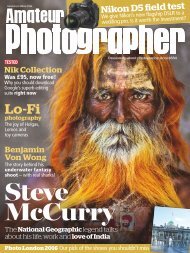You also want an ePaper? Increase the reach of your titles
YUMPU automatically turns print PDFs into web optimized ePapers that Google loves.
THE BULLET THAT KILLED MOND<br />
The Bullet Cluster is often claimed as a smoking gun for dark matter.<br />
Rubin operates the 2.1-meter telescope at Kitt Peak National Observatory.<br />
Kent Ford’s spectrograph is attached so they can measure the speed<br />
of matter at different distances from galaxies’ centers. NOAO/AURA/NSF<br />
Dark matter is hard to believe. We can’t see it, and it barely interacts<br />
with normal matter. Vera Rubin and others inferred its presence from<br />
Isaac Newton’s laws about gravity. But what if Newton was wrong?<br />
In 1983, Mordehai Milgrom suggested Modified Newtonian<br />
Dynamics (MOND) as a more palatable explanation. He proposed that<br />
gravity behaves differently in low-acceleration regions such as the outskirts<br />
of galaxies. It neatly explained most of the galaxies Rubin had<br />
observed without invoking a mysterious new form of matter.<br />
But MOND can’t explain objects such as the Bullet Cluster, the result<br />
of two colliding galaxy clusters. Gravitational lensing (shown in blue)<br />
maps most of the mass to the bright stellar material. But galaxies carry<br />
most of their normal mass in hot gas (shown in pink from X-ray emission)<br />
and waylaid in the middle of the collision thanks to drag forces.<br />
Just as Rubin showed with her rotation curves, the Bullet Cluster<br />
proves that galaxies hold far more mass than our telescopes can see.<br />
And neither Newton nor MOND can explain that without the mysterious<br />
power of dark matter. — Korey Haynes<br />
glows white, for instance, it would show how much of that light<br />
is blue and how much yellow, and which specific wavelengths of<br />
blue and yellow. Ford’s spectrometer stood out from others at the<br />
time because it employed state-of-the-art photomultipliers that<br />
let researchers study small regions of galaxies, and not simply the<br />
entire objects.<br />
With this device, Ford and Rubin decided to look at quasars —<br />
distant galaxies with dynamic, supermassive black holes at their<br />
centers. But this was competitive work: Quasars had just been<br />
discovered in 1963, and their identity was in those days a mystery<br />
that everyone wanted to solve. Rubin and Ford didn’t have their<br />
own telescope and had to request time on the world-class instruments<br />
that astronomers who worked directly for the observatories<br />
could access all the time. Rubin didn’t like the competition.<br />
“After about a year or two, it was very, very clear to me that that<br />
was not the way I wanted to work,” she told<br />
Alan Lightman in another American Institute of<br />
Physics oral history interview. “I decided to pick<br />
a problem that I could go observing and make<br />
headway on, hopefully a problem that people<br />
would be interested in, but not so interested [in]<br />
that anyone would bother me before I was done.”<br />
Rubin and Ford chose to focus on the nearby<br />
Andromeda Galaxy (M31). It represented a<br />
30 ASTRONOMY • JUNE 2016<br />
“My entire education<br />
highlighted how<br />
fundamental<br />
DARK MATTER is to<br />
our current understanding<br />
of astrophysics.”<br />
— Emily Levesque<br />
return to Rubin’s interest in galaxy dynamics. “People had inferred<br />
what galaxy rotations must be like,” said Rubin, “but no one had<br />
really made a detailed study to show that that was so.” Now, because<br />
of Ford’s out-of-this-world spectrograph, they could turn the inferences<br />
into observations.<br />
When they pointed the telescope at M31, they expected to<br />
see it rotate like the solar system does: Objects closer to the<br />
center move faster than ones toward the edge. Mass causes gravity,<br />
which determines the speed of rotation. Since most of the<br />
stars, dust, and gas — and therefore gravity — is clustered in<br />
the middle of galaxies, the stuff on the periphery shouldn’t feel<br />
much pull. They concentrated their observations on Hydrogen-II<br />
(HII) regions — areas of ionized hydrogen gas where stars have<br />
recently formed — at different distances from the galaxy’s center.<br />
But no matter how far out they looked, the HII regions seemed to<br />
be moving at the same speed. They weren’t slowing down.<br />
“We kept going farther and farther out and had some disappointment<br />
that we never saw anything,” says Ford.<br />
“I do remember my puzzling at the end of the first couple of<br />
nights that the spectra were all so straight,” said Rubin, referring<br />
to the unchanging speed of the various HII regions.<br />
They didn’t know what, if anything, it meant yet.<br />
The project took years and involved treks westward to telescopes.<br />
Ford recalls flying to Flagstaff, Arizona, dragging the spectrograph<br />
from the closet, working for a few nights at Lowell, and then throwing<br />
the instrument into a Suburban so they could drive it to Kitt<br />
Peak. “We both thought we were better at guiding the telescope,” he<br />
says. They raced each other to be first to the eyepiece.<br />
The data came out on punch cards, which Rubin spent hours<br />
analyzing in a cubbyhole beneath a set of stairs. They all showed<br />
the same thing.<br />
Rubin and Ford moved on from M31 to test other galaxies and<br />
their rotation curves. Like an obsessive artist,<br />
each painted the same picture. Although<br />
the result contradicted theory, and although<br />
they didn’t understand what it meant, no one<br />
doubted their data. “All you had to do was<br />
show them a picture of the spectrum,” Rubin<br />
told Lightman. “It just piled up too fast. Soon<br />
there were 20, then 40, then 60 rotation curves,<br />
and they were all flat.”<br />
(BULLET CLUSTER) X-RAY: NASA/CXC/CFA/M.MARKEVITCH ET AL.; OPTICAL: NASA/STSCI; MAGELLAN/U.ARIZONA/D.CLOWE ET AL.; LENSING MAP: NASA/STSCI; ESO WFI; MAGELLAN/U.ARIZONA/D.CLOWE ET AL.






